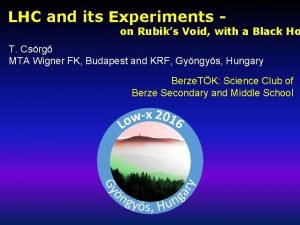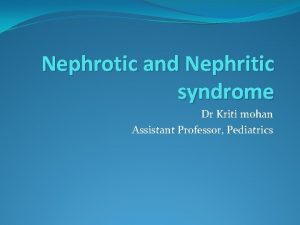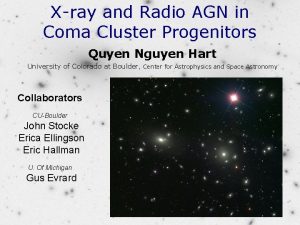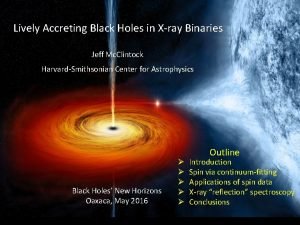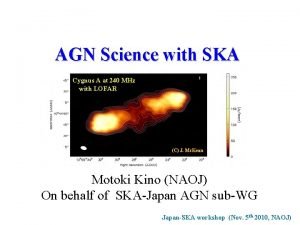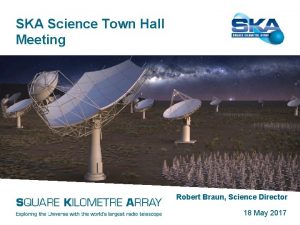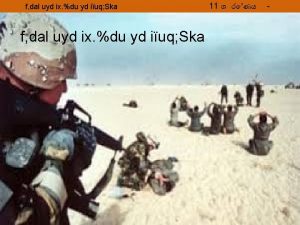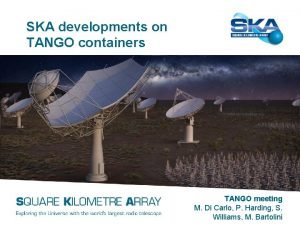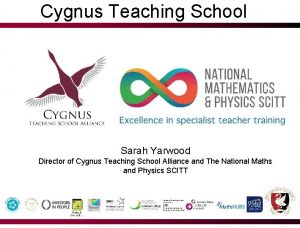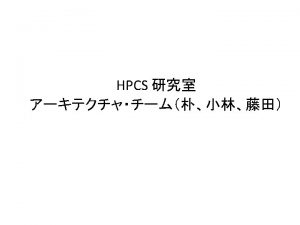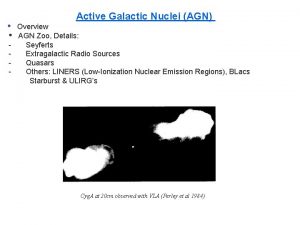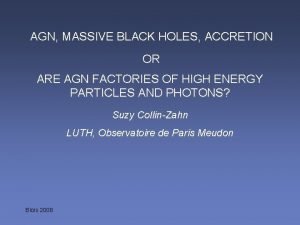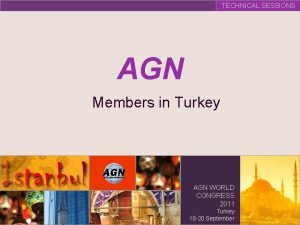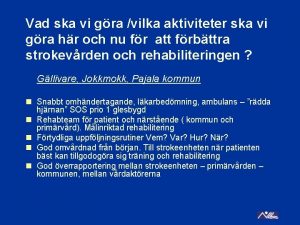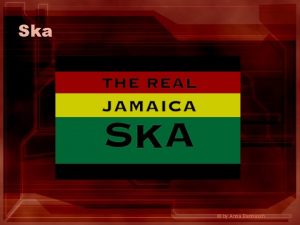AGN Science with SKA Cygnus A at 240











![Imaging Accretion Disk-Corona 4 Log νLν [erg/s] 6 Kawaguchi +01 Disk black body 45 Imaging Accretion Disk-Corona 4 Log νLν [erg/s] 6 Kawaguchi +01 Disk black body 45](https://slidetodoc.com/presentation_image/546837ecef42f2d9495fc0fde6288101/image-12.jpg)



- Slides: 15

AGN Science with SKA Cygnus A at 240 MHz with LOFAR (C) J. Mc. Kean Motoki Kino (NAOJ) On behalf of SKA-Japan AGN sub-WG Japan-SKA workshop (Nov. 5 th 2010, NAOJ)

Members N. Kawakatu (Tsukuba Univ. , Representative) M. Kino (NAOJ, Jr. Representative) T. Kawaguchi (Tsukuba Univ. ) H. Nagai (ISAS/JAXA) H. Ito (Tohoku Univ. ) S. Kameno (Kagoshima Univ. ) A. Doi (ISAS/JAXA) M. Imanishi (NAOJ/Subaru) M. Umemura (Tsukuba Univ. )

Outline 1. Why AGN with SKA? 2. AGN outflow 3. AGN inflow 4. Summary

Why AGN with SKA? Because it will have VLBI-order resolution (D~3000 km) with sub-μ Jy revel sensitivity! Wilkinson 2004

Points can be summarized into the following two concepts: 1. Filling the gap between VLBIs and VLA 2. Quest for very faint radio emission

AGN outflow - kpc jets - Cocoons - Radio-quit AGNs Kino, Nagai, Ito, Kawakatu

Internal Structure in shocks@kpc? In general, it is not easy to see knots by current VLBI’s sensitivity. Koyama, MK+ in prep 3 C 380, VLA 15 GHz 1 arcsec=6. 9 kpc VLBA+Y 1, 1. 4 GHz as m 0 73 2 kpc K 1 core B amplified!? O’dea+98 Beyond 1 -zone: K 1 = compact + diffuse region? ⇒ SKA@mid/high-band => Particle acceleration

Motion@kpc? It is very difficult to detect motions at kpc jets by VLBIs/VLA. Cygnus A c p k 50 1 10 pc VLBIs see only here. Krichbaum+ Very few reports on jet motions at ~kpc. ⇒ SKA@high-band => Relativistic Hydrodynamics

Low Energy Electrons Low-energy-electrons tell us the true shape of jet-remnants (not lobes but a cocoon) because of its longer cooling time. VLA@5 GHz Chandra+ VLA@330 MHz LOFAR @240 MHz Yaji+ 2010 (C) J. Mc. Kean SKA-low band will show us a new world of radio cocoon. => True total power of jets (MK+05, Ito+08)

“Radio-quiet” is really radio-quiet? Observations of “radio-quiet” populations have been started (ex. Narrow Line Seyfert 1 galaxies) Doi+ 2007 By Japanese VLBI Network@8 GHz SKA’s sensitivity will allow us to detect weak radio emission from currently “radio-quiet” AGNs. =>Hint for underdeveloped jets?

AGN inflow -Imaging Accretion Disk-Corona -Quest for AGNs in ULIRGs/BCDs Kawakatu, Kawaguchi, Imanishi, Umemura, Doi, Kameno, Hirashita
![Imaging Accretion DiskCorona 4 Log νLν ergs 6 Kawaguchi 01 Disk black body 45 Imaging Accretion Disk-Corona 4 Log νLν [erg/s] 6 Kawaguchi +01 Disk black body 45](https://slidetodoc.com/presentation_image/546837ecef42f2d9495fc0fde6288101/image-12.jpg)
Imaging Accretion Disk-Corona 4 Log νLν [erg/s] 6 Kawaguchi +01 Disk black body 45 n -1 44 43 g bre n* ~20 GHz n -1 41 40 - Size : ~ 300 Rs - Brightness temperature: Tb ~109 K for ν < 20 GHz - Targets : Nearby Seyferts SKA 39 38 a str s m Cyc-syn emission 42 9 10 11 n u l h 12 13 14 15 Log ν [Hz] 16 17 18 Higher freq. is preferable to resolve it. ⇒ SKA@high-band 19

AGN or Star-Burst in ULIRGs? Which is the energy source of ULIRGs ? Luminous energy sources behind dust @z <0. 1 IR-spectroscopy study (Imanishi+06, 07, 08, 09) AGN: compact ? ★ SB Star-Burst: extended High surface brightness radio core emission = AGN Observations with high spatial resolution avoiding free-free absorption are required. ⇒ SKA@high-band

AGNs in Blue Compact Dwarfs? metal poor II ZW 40 (age ~ 3 Myr) SMA (5’’) VLA(3 -4’’) Hirashita & Sakamoto (in preparation) VLA(0. 1”): Beck+02 Free-Free AGN (RIAF) ν 1/3 SKA 0. 6 Star burst -0. 1 ν (Free-free) Spectral index is the key to distinguish them. ⇒ SKA@mid-band frequency (1 -15 GHz)

Summary 1. AGN outflow - kpc scale jets - Radio Bubbles: Super-sonic or sub-sonic? - Cocoons - “Radio-quiet” AGNs 2. AGN inflow - Imaging nearby Accretion Disk-Corona - Quest for AGNs at the core of ULIRGs - Quest for AGNs at the core of BCDs
